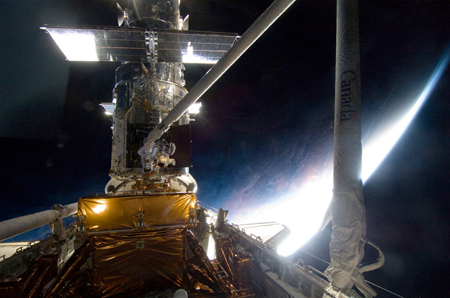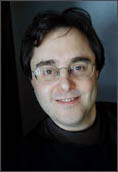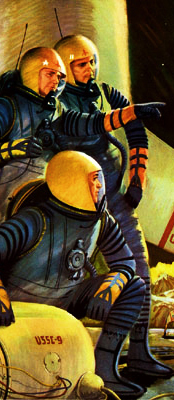
In December 2003 I took part in a closed-door roundtable discussion on NASA’s goals in space and how to relate them to the public, led by then NASA administrator Sean O’Keefe. Among the participants was filmmaker Jim Cameron, creator of such epics as Titanic, Terminator, and the upcoming Avatar. At one point, as I was voicing my frustration at NASA’s past failures to communicate its activities in a compelling way, Jim zeroed in on the real problem. “It’s not enough to tell the story,” he said. “You have to have a good story to tell.”
I thought of Jim’s comment the other day when I was watching spacewalking astronauts of the shuttle Atlantis repair and refurbish the Hubble Space Telescope. I sat there in front of my computer–none of the kaleidoscope of channels on Comcast were covering the event–and watched live video of the astronauts performing the equivalent of brain surgery on the beloved telescope, transcending the limitations of bulky spacesuits and stiff, pressurized gloves in an extraordinary weightless ballet. And once again, as I always do when the space program is at its best, I felt amazed, inspired–and grateful.
In short, I felt the way I almost never do any more when I watch astronauts working in space, even when the tasks are just as challenging, the views just as magnificent. Fixing Hubble, giving it new life and new capabilities, is the kind of thing that’s worth the cost and the risks of sending people into space. What we’ve gotten from that orbiting discovery machine, aesthetically as well as scientifically, is priceless. Yet, for all the engineering magnificence of the International Space Station–and, for that matter, the shuttle itself–it’s hard for me to avoid the feeling that all those flights, those countless hours of station-contruction spacewalks, haven’t gotten us much farther along the road to new explorations, new discoveries. Maybe someone out there will convince me I’m mistaken. But right now, I long for more missions like the Hubble repair, more good stories to tell.



{ 11 comments… read them below or add one }
Greetings from (horrible weather) KSC Andy –
Insightful story all the way. Interesting image. The “telling” from NASA has to evolve or the next 50 will be repeat template of the last 50…. Sorry you couldn’t have been with us in mission control. Would have been a great combo of you writing and me making images. So yeah, It is still awe and wonder .. Kind of like those illustrations that Von Braun and Wily Lee used in those 1950’s book on “Space Travel” … Am just now rapping up two intensive behind-the-scenes months with the SM4 crew and Hubble team. What a mission. Hopefully they will land here between Friday and Monday.
NPR did a piece on launch day and used created a photo gallery around my EVA tool photography ….
http://www.npr.org/templates/story/story.php?storyId=103915475
Be well and regards to V
PS: What do you think of the posted crew photography of this mission?
Hi Andy –
While I whole heartedly agree with your statment about the incredible work to refurbish the Hubble, I disagree about your statement that the construction work on the ISS hasn’t “gotten us much farther along the road to new explorations.”
You and I had the great fortune to grow up and see the first explorations off our planet and maybe that has made us a bit jaded. Understandibly so. But think of the construction workers who built the Great Pyramids, the Eiffel Tower, the Saturn V or any magnificent museum or laboratory. When those things are used as intended we watch in awe at what they can produce but we don’t think about the countless hours building them.
The ISS took longer to assemble than expected but the incredible ballet of EVA’s is the same as Hubble. The only difference is that Hubble has generated an impressive history of scientific discovery that ISS has yet to do. Please be patient because I believe we will one day look upon the ISS with the same awe as we do with Hubble.
Thanks,
Tim
Hey Andy:
Yes, Hubble has been an inspiration to people from every walk of life, economic strata, and geographic location in the US. Like you, I’ve talked to a lot of people about the space program, and Hubble, Cassini and MER are the ones that still get the attention. For all the excellent science and engineering under its belt, the ISS does not. I think the feeling is that paddling around in our own lagoon (as John Logsdon has put it) does not inspire any more. I think NASA is on the right track with its Constellation concept of building infrastructure to take us beyond Earth orbit. Constellation’s end point is not a permanent presence on the Moon, but rather a way to enable humanity to travel to distant destinations like Mars, asteroids, etc. This is the inspirational stuff that we yearn for.
Keep up the great blog, Andy!
Mikey
Congrats Andy on getting your blog off the ground. This is my first ever blog entry, so I’m delighted it is on your site. Re: media coverage of the latest and last Hubble refurbishment mission, I did see some decent pieces on CNN, on the local Boston-area television news, and an interview with Jeff Hoffman and Kelly Beatty on ??? Rooney’s WGBH show. However, I also agree with you that the amazing story of these heroic astronauts repairing this wondrous space telescope is far from achieving the sort of visibility that we experienced with the Apollo program.
In many ways, the urgency of human space flight has diminished. Other scientific and technological issues have taken its place — with understanding and fixing our relationship with the biosphere topping the bill. Consequently, I see human space missions to the Moon, Mars, and beyond as longer-term abiding challenges that will ensure our survival as a species (after the next really big asteroidal impact for example) and will actualize our natural birthright as participatory citizens of the Milky Way. A spacefaring future is truly before us — perhaps at a slower pace than anticipated — but nonetheless worthy of sustained investment.
Ever onward 🙂
Bill
Andy,
That beautiful live video of the Atlantis astronauts working on Hubble did oddly revive fond memories of the live Apollo broadcasts from the moon. I suppose that one reason that this video seemed more inspirational than the video from ISS construction missions is that we were aware that this mission is dedicated to extending the operational life of the Shuttle program’s greatest and most inspiring gift, the Hubble Space Telescope.
The fact that these astronauts also willingly accepted the additional risk of flying out of plane with the International Space Station’s “safe haven” orbit added some extra spice to the flight of STS-125. We will never know if that standby, rescue Shuttle attempt would have actually worked.
While the Space Shuttle never lived up to the promise of cheaper, more frequent access to space, it did- unfortunately- make space travel seem almost painfully routine from the perspective of most citizens.
The Challenger and Columbia tragedies did serve as terrible reminders that space travel is filled with potentially deadly hazards, but most of the Space Shuttle missions seemed terribly tedious and workaday in comparison to the flights of Mercury, Gemini and Apollo.
The Space Shuttle, an incredibly complex and marvelous machine, seemed anti-climactic to that generation that witnessed that dramatic, rapid-fire succession of increasingly ambitious 1960s space missions. It was kind of like we bought an old Chevy El Camino to replace a Ferrari.
The long-delayed ISS has yet to return the kind of scientific dividends that its proponents promised. I hope that the ISS science complex will eventually prove to be worth the expenditure of dollars and time that it took to build it. The real problem with ISS is that no science experiment can ever be as inspirational as Pete Conrad’s hoots and hollers after he landed Intrepid only 600 feet from Surveyor 3.
At the very least, the ISS project kept many former Soviet space workers gainfully employed in a peaceful pursuit while Russia endured some very difficult years.
Scientific investigation is a very important part of our space activities. Sending people further and further into space is at least as important as the basic science we do in space. We need to stop thinking of space as a distant, separate place.
Human beings have been lucky enough to emerge from nature during a rather quiescent time for our planet. We have learned a lot about our planet by leaving it. We learned some things by looking back at our planet from space. We learned a lot more by looking closely at and actually visiting other planets and moons in our solar system. We learned that our planet is shielded from deadly space hazards such as cosmic rays and coronal mass ejections.
We also learned that we are not shielded from some other space hazards such as Near-Earth Asteroids and comets. We learned that mass extinctions are inevitable and that the forces of extinction may come from terrestrial or extraterrestrial sources. Our existence is precarious.
It is clear that our desire to venture beyond the horizons of earth is driven by our instinct for survival. We don’t know when megadeath will come. Likewise, our ancestors could not predict the coming of droughts, locusts and other natural disasters that could render their home territory uninhabitable. Their is no doubt that our ancestors were occasionally forced to explore, to seek out new and fertile lands. Eventually, our ancestors learned that it is useful and wise to explore and settle new lands before the next disaster strikes. The legacy of human exploration is no doubt more ancient than writing, weaponry, or intelligible speech.
Science is good, robotic explorers and remote sensing are priceless, but human space exploration and space exploitation are driven by an irresistible, primal urge that is wired within us long before we learn how to read and write or later earn PhDs in astronomy or biochemistry.
There are some good stories to tell from the Space Shuttle era, but by and large, the Space Shuttle was like a lot of sequels – tiresome and disappointing. TERMINATOR was followed by some great sequels. Apollo was not followed by a great sequel. If the Space Shuttle was a movie, it might be titled Titanic II.
-Jim (Still Space Crazy in Alabama)
PS- I hope my markup worked. If not, just imagine the italics.
Aloha nui Loa Andy,
from the most isolated landmass on Earth–the Hawaiian archipelago. I count my blessing each day I wake up here in paradise. The most wonderful priviledge of living in for Hawaii going on three decades is that I have absorbed so much ‘mana’ Hawaiian spirit and kahiko (ancient culture) and been humbled by the Hawaiian approach to life and living. I have just returned from a hula kahiko halau (ancient hula practices) meeting where we had a guest speaker a descendent of Kamehameha II–the Hawaiians can trace their lineage back 1,500 years through their chants.
The kumu or teacher tonight was interpreting sections of the Kumu Lipo –the 2,000 plus line chant that describes the beginning of the Universe. I love the Hawaiian language and it was surprising to me how accurate the chant was.
But the most important lesson I got from this talk tonight–and all Hawaiian cultural events have a lesson–always one of the heart and soul as well as for the mind–was that we can all complain about this and that and why we blame someone else or something else or some government official or WHAT EVAH! but what we really need to do is start making changes in oursleves first and these small changes will affect the world. The ripple effect. All Hawaiian culutre is based on the premise that if we are at peace with our own hearts, treat everyone with the respect we would like to get ourselves, think before we speak harshly, always ask permission–for everything, then we can leave an imprint and maybe that will affect someone else, and so on and so on.
Steve is away in Papa Niugini. So goodnight Brah,
Love, Donna O
Hi all,
I’ve given up on television (and even Nasa TV.) I get almost all my space coverage from Spaceflightnow.com and Space.com. Television (in general) is no longer a source for news, only opinions which cater to the demographic that a particular network is targeting. There’s nothing “spontaneous” about any of it. The only time spaceflight makes it onto network or cable television (I know I’m painting with a broad brush) is when things are not going well. This I believe will be the ultimate problem with NASA’s approach to ISS. Its exciting when they’re building it but over time the networks will tire of the science aspect and focus on the slow, inevitable deterioration of the components. Television will eventually force ISS into the model they formed for news concerning MIR. Every little issue; a failed solar panel drive, a broken toilet, a leak, an impact with orbital debris (lets hope its really small) will be the only things that rise to the level of broadcast worthy. Its the networks that decide what the “good” story is, not NASA.
This is where Hubble succeeded. It walked the fine line between creating something that was beautiful and compelling to the average person but also produced the reams of data from other sensors (which no one outside of academia ever saw) needed for scientific investigation. I fear the decision to not put a “visible” sensor on the James Webb telescope will make that system harder for the average person to love and therefore less compelling than Hubble. I hope I’m wrong.
Who among you agrees with me that NASA should have named the new node on the ISS after Steven Colbert? It would have been something that all of us took part in and could have owned. By ignoring the vote NASA again showed that its Congress’ opinion that matters and they missed a chance to imbue the ISS with some of the personality that has so far been only bestowed on the Mars Rovers.
We have to accept that NASA is never going to be able to control the story. What they need to do is create the context within which great stories can be told.
After being married to Konrad for almost 19 years, I can only reflect in awe of what he and over 400,000 space workers did to get us up on the Moon. In discussing how to tell a story, I have to say Duncan Copp did a WONDERFUL job not only on IN THE SHADOW OF THE MOON but MOON MACHINES as well. Of course, Konrad was featured on MOON MACHINES so I can’t help but be prejudiced. However, talk about telling a GOOD story.
I worry that Konrad’s and the rest of those 400,000 space workers dreams and legacy will just slowly fade away. We all have to admit, the biggest driving force for going to the Moon was to beat the Russians. That makes it mostly political in purpose. The best part of it was HOWEVER is that we as a nation showed what GOOD we could do when rallied to the cause. It still infuriates me hearing those who say we never went to the Moon. Tell those 400,000+ space workers that !
I had the good fortune of watching most of the U.S. habitable elements to ISS undergo the welding process and come together as a whole unit to include Node 1 (Unity), the Lab Module (Destiny), the Hab Module which will never fly, the Airlock and Node 2 which also will never fly. I was able to see them put together the racks which are in each of those modules. All this took place at Marshall Space Flight Center in Bldg 4708. What a gas that was ! I was a tour guide for the US Space and Rocket Center so I was lucky to see these elements come together pretty much on a daily basis. I really looked forward to each morning to see what they had accomplished overnight. Of course they didn’t let the general public in when the actual welding was taking place. But to see it all come together was SUCH a thrill.
Now that ISS is finally pretty much looking in reality “as advertised, it’s quite exhilarating. I can’t tell you how thrilling it is for me to see pictures of it now. What it does is reminds me of the PEOPLE who put it together. Thousands and thousands of people similar to the Saturn V. Don’t tell me that the ISS people didn’t feel those Saturn V souls looking over their shoulders in support and guidance in one form or another. Konrad always praised their efforts and they appreciated it !
Now we are finally ready to put a full crew on board to finally get ISS up to speed as advertised and do some REAL good for research and experimentation. However, I have it from a very good source that the real farce to all this is in cutting ISS costs, the easiest place to start cutting was in the experiments themselves. They’re going to all be up there with almost nothing to do but upkeep on the station. Now how STUPID is THAT ? WHY can our elected officials not have at least ONE DROP of common sense ? How is it that we can get programs almost to the point of being operational only to have the budget slashed and the program cancelled ? In many cases, it costs more to shut it down than it would to operate it ! WHAT ARE THEY THINKING ??? I’ve also heard from another VERY reliable source that over a ten year time period very recently, NASA has spent $40 billion in CANCELLED PROGRAMS !
It’s understandable Andrew how you can get excited about Hubble and sad about ISS. Hubble is putting out REAL science ! It’s one of the best programs we have recently that most Americans who are NOT space enthusiasts are familar with.
I can tell you ONE fun story in closing. Back in the beginning of Mike Griffin’s tenure as NASA Administrator, he came to Huntsville for some big event at the von Braun Civic Center. I can’t remember what the event was but he was the keynote speaker. Following the event when everyone was talking and getting ready to leave, Konrad asked me if I could go get Mike so he could talk to him. Konrad was getting less and less mobile and that was the start of that basically. I went and asked Mike if he would be willing to talk to Konrad and he said absolutely he would and was more than happy to go to Konrad rather than visa versa. After Mike arrived and all the greetings were said, Konrad cut right to the topic he most wanted to discuss. Wearing his Hubble tie that I gave him, Konrad asked point-blank why wasn’t there going to be another Hubble Service Mission. A NASA photographer caught the moment in a picture I will treasure for the rest of my life. Within a year, Mike Griffin announced that there would indeed be another Hubble Service Mission.
Now I can’t say for sure if Konrad had ANY influence on this but I’d like to think so. People like Konrad NEVER stop dreaming, questioning and listening. It’s people like him and the Saturn V and ISS space workers who all question “Why not ?” ! I would REALLY like to see the TRUE purpose for ISS to become a reality and get the funding back so that we can see TRUE return on investment !
Andy,
Good to see the blog!
I am your age, and share both your enthusiasm and angst. The words that keep ringing in my ears are those by Buzz – “We are still languishing in low-earth orbit”.
Still, America is far more fixated on ‘American Idol’ than space travel, international awareness or the economy, and is spoon-fed trivia and irrelevance by the magnate-run media.
If aliens monitored our planet, particularly the US, they would discern that the most successful people either play games or pretend to be others. Sportsmen and actors.
Not scientists, engineers, or explorers.
Our funds are spent in the pursuit of the destruction of each other, and the planet. Yep, we’re a smart bunch alright.
“You don’t get what you deserve, you get what you negotiate”. This is the very saddest indictment of our civilization, because, staggeringly, it is true. Integrity has no place in our society it seems. Unfortunately, NASA is deserving, but not good at negotiating. Oh well, I am looking forward to reading ‘Voices’ anyway – thanks!
Mr. Chaikin,
Not to take away from any of the amazing accomplishments of the entire shuttle program and it’s people, but I agree with you. One of the limitations of the present program in my opinion is, we don’t “go” anywhere. Even when we did in Apollo, the public got bored. We are a nation of “quick results” and “what have you done for me lately”. The slower, long term and ultimately longer lasting efforts of the shuttle atronauts and the ISS don’t fit into the “more, better, faster” attitude that permeates our culture. It’s unfortunate and sad.
That being said, I fervently hope that Orion and the follow-on planned return trips to the moon wll manage to survive. I’m fearful we will walk away from them as we walked away from Apollo. Great empires and great societies decline, implode and fade when they turn away from exploration. In some ways, we already resemble an empire in decline. I think we’re at a critical moment in our history, and need to decide if we will continue to push on into the unknown, or turn-in on ourselves and be satisfied with bread-and-circuses until we become just another footnote in the long list of fallen cultures.
I greatly appreciate yours and other’s efforts that keep the Apollo legacy alive, and those people in NASA today that contnue to push the frontier forward. Please know there are still many of us out here who know and appreciate what you do, and we are trying to instill that appreciation in our children.
Please keep up the great work!
Jackie- that’s a beautiful note you’ve written. Konrad was an amazing man. I only me him once, at a session of SpaceCamp that was the first group of journalists admitted (I think it was 1985?)… he was there to instruct us on rocket propulsion. Though we were a bunch of scoundrels, he was very patient and his lecture was fascinating. It was a bit like the perfect undergrad lecture from a luminary professor- he should have been doing something much more important, but he was kind enough to share his knowledge with us.
After the talk he invited us to a bar in Huntsville called, I think, Old Heidelberg. What an evening that was! There was Konrad (I should probably say “Mr. Dannenberg”) singing his heart out around a piano with some other original Rocket Men. Truly an amazing moment. Then he joined us for a long discussion about the future of NASA and space exploration. And this was just a few months before that terrible day with Challenger.
It was probably one of the most inspiration evenings I have ever experienced. I am so sorry for his passing. He was truly a member of the pantheon.